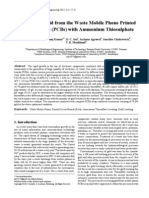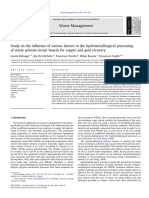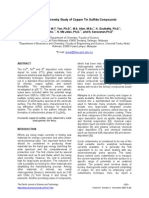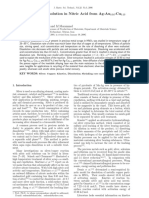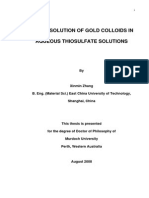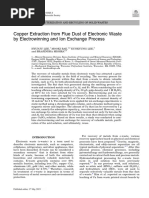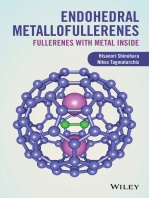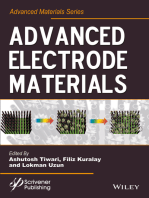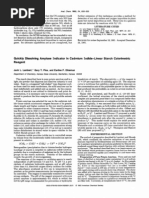Leaching of Gold and Silver From Crushed Au-Ag Wastes: Jana Ficeriová, Peter Balá, Erika Dutková and Eberhard Gock
Leaching of Gold and Silver From Crushed Au-Ag Wastes: Jana Ficeriová, Peter Balá, Erika Dutková and Eberhard Gock
Uploaded by
Dgek LondonCopyright:
Available Formats
Leaching of Gold and Silver From Crushed Au-Ag Wastes: Jana Ficeriová, Peter Balá, Erika Dutková and Eberhard Gock
Leaching of Gold and Silver From Crushed Au-Ag Wastes: Jana Ficeriová, Peter Balá, Erika Dutková and Eberhard Gock
Uploaded by
Dgek LondonOriginal Description:
Original Title
Copyright
Available Formats
Share this document
Did you find this document useful?
Is this content inappropriate?
Copyright:
Available Formats
Leaching of Gold and Silver From Crushed Au-Ag Wastes: Jana Ficeriová, Peter Balá, Erika Dutková and Eberhard Gock
Leaching of Gold and Silver From Crushed Au-Ag Wastes: Jana Ficeriová, Peter Balá, Erika Dutková and Eberhard Gock
Uploaded by
Dgek LondonCopyright:
Available Formats
6
The Open Chemical Engineering Journal, 2008, 2, 6-9
Leaching of Gold and Silver from Crushed Au-Ag Wastes
Jana Ficeriov*,a, Peter Bal�a, Erika Dutkova and Eberhard Gockb
a b
Institute of Geotechnics of the SAS, Watsonova 45, 043 53 Ko�ice, Slovakia
Institute of Mineral and Waste Processing and Dumping Technology, Technical University Clausthal, Walther-Nernst Strasse 9, 38 678 Clausthal-Zellerfeld, Germany
Abstract: Au-Ag noble metal wastes represent a wide range of waste types and forms with various ballast elements and components. The thiourea process of gold and silver extraction from ores, concentrates or secondary raw materials consists of gold and silver leaching into the thiourea solution and the consequent precipitation of these metals from the solution. Due to the non-toxic character of thiourea it is the perspective alternative to the up to now most frequently used cyanide method. The thiourea leaching of gold and silver from electronic waste, goldsmiths waste and ceramic waste using crushing as the pretreatment step was investigated. For electronic waste, it was possible to achieve 97 % gold and 94 % silver recovery within 120 minutes of thiourea leaching. Up to 98 % of gold and 96 % of silver were recovered from goldsmiths waste after 60 minutes of leaching. In the case of ceramic waste, we achieved up to 98 % gold and 97 % silver extraction efficiency after only 45 minutes of leaching. In comparison with the classical cyanide leaching, thiourea leaching acts faster and without a harmful environmental impact.
Keywords: Waste, Gold, Silver, Crushing, Leaching. 1. INTRODUCTION Electronic waste comprises electric waste and includes an extremely complex mixture of electric, electronic and other components. Sources are production waste from the electric and electronic industry as well as defect or technically obsolete devices for which there is a legal obligation for disposal on trade and municipalities [1]. The main components of electronic waste are approximately: 45 % ferrous metals, 10 % non-ferrous metals (mainly Cu and Al), 22 % plastics and 9 % glass. In contrast, the average fraction of electronic components is only 3 %. Most utilization firms call the circuit board including the attached elements and the frame electronic components. From this viewpoint, the fraction of electronic waste is usually between 20 and 30 % [2, 3]. There are considerable differences between the composition of the individual groups of electronic waste and even within one group. For assistance, washing machines and refrigerators consist almost completely of ferrous metals and contain a very small fraction of electronics. Computers and entertainment electronics, however, have a high fraction of electronics. The percentage of noble metals is much higher in computers than in the other categories of electronic waste. The following examples give some general indications: low value (< 100 ppm Au) TV-boards, monitor boards, (cordless) phones, calculators, shredded bulk material after Al-Feseparation; medium value (100 to 400 ppm Au) PC-boards, laptop- and handheld-computers, some mobile phones; high value (> 400 ppm Au) Circuit boards from main-frames, some mobile phones, multi-layer ceramic capacitors [4]. The secondary resources of gold are generated by craftsmanship and industrial processing of gold and alloys thereof (goldsmiths fractions and fillings, abrasives tailings, clad clock waste and used melting crucibles); by amortization of products (ceramic waste, old jewelry and fractions thereof, dental alloys, graded electrical and electronic waste, nongraded electronic waste); by collecting (medals, coins, bank alloys, sacral and museum treasures), gold lost in the seas and oceans, buried in the graves and in the decommissioned deposits [5]. Gold and silver is impractical connected on the component of Au-Ag wastes included with abundance of accompanying elements and cannot come in contact with leaching solutions. Leaching of Au-Ag wastes without pretreatment remitted in low Au and Ag extraction [6]. Physical pretreatment by crushing have been applied to Au-Ag wastes with the aim of changing the part sizes of the gold and silver-bearing wastes, thus facilitating the subsequent leaching in order to increase the recovery of noble metals [7, 8]. Crushing induces changes size of component parts of Au-Ag wastes. It increases the fraction of components and improves their contact with leaching reagents. Modern hydrometallurgy of gold and silver is based on the application of cyanide leaching. The cyanide process is a highly toxic technology. The thiourea process of gold and silver extraction from wastes or concentrates consisting of gold and silver leaching into the thiourea solution, and consequent precipitation of these metals from the solution is, with regard to the very low toxicity of thiourea, the perspective alternative hitherto the most used cyanide method. Thiourea leaching has more rapid kinetics for gold and silver solubilization than classical cyanide leaching [9-13]. The aim of this work was to examine the possibility of recovering gold and silver from electronic, goldsmiths and ceramic wastes using thiourea leaching. Crushing was ap2008 Bentham Science Publishers Ltd.
*Address correspondence to this author at the Institute of Geotechnics of the SAS, Watsonova 45, 043 53 Ko�ice, Slovakia; Fax: + 421-55-7922604; E-mail: ficeri@saske.sk 1874-1231/08
Leaching of Gold and Silver from Crushed Au-Ag Wastes
The Open Chemical Engineering Journal, 2008, Volume 2
Table 1.
Chemical Composition of Au-Ag Wastes Under Study
Components (%) Waste Au Ag 0.18 0.45 0.35 Cu 0.85 0.53 0.6 Pb 0.0003 0.041 0.0007 Zn 0.24 0.012 Fe 0.35 0.008 Br 0.52 Sn 0.41 Ni 0.13 0.005 0.003 Sb 0.016 0.004 Mn 0.002 0.0003 -
Electronic (Germany) Goldsmiths (Slovakia) Ceramic (Czech Republic)
0.25 0.8 0.4
plied in order to determine its effect on the recovery of gold and silver. 2. EXPERIMENTAL 2.1. Materials The electronic waste (PC-boards, Germany), goldsmiths waste (abrasive papers, Slovakia) and ceramic waste (pink porcelain, Czech Republic) were selected as materials for testing the thiourea leaching of gold and silver. The chemical composition of the studied wastes is given in Table 1 . 2.2. Physicochemical Characterization The X-ray fluorescence spectroscopy (XRF) was done using a Philips PW 1404 (X-tal LiF 200) spectrometer equipped with a source operating at 40 kV and 30 mA. Data
were collected every second and the detector was moved at a rate of 0.1o min-1. 2.3. Crushing of Au-Ag Wastes Rotoplex-shredder crusher A20/12 Ro and Omniplexhammer crusher 40/20 Ha (both Alpine, Germany) were used for treatment of electronic, ceramic and goldsmiths wastes. After crushing, the material was 8x8 mm in size in case of goldsmiths waste and -800 m in case of electronic/ceramic waste. Before leaching the waste has been sieved. 2.4. Thiourea Leaching of Au-Ag Wastes The leaching was investigated in a 500 mL glass reactor into which 400 mL of leaching solution having 10 gL-1 CS(NH2)2, 5 gL-1 Fe2(SO4)3.9H2O, 10 gL-1 H2SO4 and 50 g
Fig. (1). X-ray fluorescence spectrum of electronic waste (A), goldsmiths waste (B ) and ceramic waste (C ).
8 The Open Chemical Engineering Journal, 2008, Volume 2
Ficeriov et al.
of crushed electronic, goldsmiths and ceramic wastes were added. The leaching was performed at pH 1 for up to 120 min at 293 K using a stirring rate of 8.33 s-1. Aliquots (5 mL) of the solution were withdrawn at appropriate time intervals for determination of the content of dissolved gold and silver by AAS method. The leaching kinetics of gold and silver were best fitted by the kinetic equation:
� ln ( 1 � � x ) = k X t L
(1)
received sample 87 % of gold and 83 % of silver was recovered after 120 min of leaching in thiourea (Fig. 5). The results for the treated waste indicated that the comminution of the Au-Ag waste brought about an acceleration of the leaching process. In this case, it was possible to achieve 99 % gold recovery and about 96 % silver recovery after less than 60 min of leaching. Here, the recovery of accompanying metals was 87 % for Cu, 55 % for Fe and 28 % for Zn. Me 100
[ %]
80 Au Ag 60 Cu Fe Zn 20 Pb
where �x is recovery of gold/silver into the leach solution, kX is the rate constant (s-1) and tL is the leaching time (s). Thiourea, CS(NH2)2 forms a stable soluble complex with gold and silver ions. Bruckard [14] suggested the equations for gold and silver dissolution in the presence of Fe3+ ions as:
2+ + Au + 2 CS ( NH 2 ) 2 + Fe3+ � Au � � CS ( NH 2 ) 2 � � 2 + Fe
40
(2)
2+ + Ag + 3 CS ( NH 2 ) 2 + Fe 3+ � Ag � � CS ( NH 2 ) 2 � � 3 + Fe (3)
0 0 20 40 60 80 100 120
tL [ min ]
Fig. (3). Recovery of Au, Ag, Cu, Fe, Pb and Zn, �Me vs. leaching time, tL for as- received sample of electronic waste (Germany).
3. RESULTS AND DISCUSSION 3.1. Thiourea Leaching of Gold and Silver from Crushed Au-Ag Wastes The X-ray fluorescence spectral records of the Au-Ag wastes under study, are shown in Fig. (1). The results confirm the presence of gold/silver and following metallic and non-metallic elements. The dependence of gold and silver recovery on the leaching time from electronic waste is shown in Fig. (2). 120 min leaching of as-received sample with thiourea yielded only a 76 % Au and 71 % Ag leachate (Fig. 3). The treatment using crushing makes it possible to achieve a more than 90 % recovery of gold and silver in the leachate even after 6090 minutes. Here, the recovery of accompanying metals was 68 % Cu, 45 % Fe, 43 % Pb and 28 % Zn. The results for crushed waste show increased recoveries of noble metals.
Me
[ %]
100 80 60 40
Au Ag Cu
Fe
Zn 20 0 0 20 40 60 80 100 120
tL [ min ]
Fig. (4). Recovery of Au, Ag, Cu, Fe and Zn, �Me vs. leaching time, tL for goldsmiths waste (Slovakia) pretreated by Rotoplex-shredder crusher, A20/12 Ro (Alpine, Germany).
Me
100
Au Ag
[ %]
80
Cu 60 Fe 40 Pb Zn
Me 100
[ %]
80
Au Ag Cu 60 Fe 40
20
0 0 20 40 60 80 100 120
20
Zn
tL [ min ]
Fig. (2). Recovery of Au, Ag, Cu, Fe, Pb and Zn, �Me vs. leaching time, tL for electronic waste (Germany) pretreated by Omniplexhammer crusher, 40/20 Ha (Alpine, Germany).
0 0 20 40 60 80 100 120
tL [ min ]
Fig. (5). Recovery of Au, Ag, Cu, Fe and Zn, �Me vs. leaching time, tL for as-received sample of goldsmiths waste (Slovakia).
Fig. (4) shows the effect of leaching time on gold and silver recovery for crushed goldsmiths waste. In the as-
Leaching of Gold and Silver from Crushed Au-Ag Wastes
The Open Chemical Engineering Journal, 2008, Volume 2
The dependence of gold and silver recovery as well as the recovery of accompanying metals (Cu and Pb) for the crushed ceramic waste is given in Fig. (6). It is possible to achieve a 98 % recovery of gold and 97 % recovery of silver into the leachate even after 45 minutes. After 120 min of leaching, 71 % of Cu and 18 % of Pb was recovered. A recovery of 90 % Au and Ag was achieved after 120 min of leaching of the as-received sample (Fig. 7).
Me
(Ko�ice) and Czech Republic (Praha) in a shredder crusher and hammer crusher influences the changes part sizes of the gold and silver-bearing wastes and this leads to an accelerated thiourea leaching. It increases the fraction of components and improves their contact with leaching reagents. Thiourea leaching is more suitable for rapid extraction of gold and silver from the given types of Au-Ag wastes than other alternatives. In this way, it is possible to achieve more then 90 % recovery of gold and silver. The process of thiourea leaching is non-toxic and moreover brings kinetic advantage over classical cyanide leaching. ACKNOWLEDGEMENTS
[ %]
100 80
Au Ag Cu
60 40 20 0 0 20 40 60 80 100 120 Pb
This work was supported by the Slovak Grant Agency for Science (Grant No. 2/0035/08). REFERENCES
[1] [2] [3] J. Shibata and A. Okuda, Recycling technology of precious metals, Resour. Mater., 48, pp. 23-31, 2003. S. Thimao and J. Shu, The recovery of gold and silver from electronic waste, J. Metals, 6, pp. 53-57, 2004. Ch. Hagelken, Recycling of electronic scrap at Umicores integrated metals smelter and refinery, Erzmetall, 59, pp. 152-161, 2006. B. Langner, Recycling of electronic scrap, Metall, 48, pp. 880885, 1994. J.E. Hoffmann, Recovering precious metals from electronic scrap and goldsmiths waste, J. Metals, 4, pp. 43-48, 2002. J. Brusselaers and J. Kegels, Eco efficient optimization of preprocessing and recycling of srap, Erzmetall 39, pp.122-131, 2004. D. Tange, Properties of ceramic and electronic wastes, Resour. Mater., 26, pp. 31-35, 2002. J. Ficeriov, P. Bal�, and E. Gock, A processing method of the goldsmiths and electronic Au-Ag containing wastes, Acta Montan. Slovaca, 10, pp. 307-310, 2005. F. Habashi, A Textbook of Hydrometallurgy: Metallurgie Extractive Quebec, Canada, 1993. P. Bal�, J. Ficeriov, V. �epelk and R. Kammel, Thiourea leaching of silver from mechanically activated tetrahedrite, Hydrometallurgy, 43, pp. 367-377, 1996. P. Bal�, J. Ficeriov, E. Boldi�rov, M. Hber, S. Jele� and R. Kammel, Thiosulphate leaching of gold from a mechanochemically pretreated complex sulfide concentrate, Developments in Mineral Processing, 13, in Proc. XXI. International Mineral Processing. Congr., Ed. Paolo Massacci, Elsevier, Amsterdam, Rome, pp. A674 - A6-81, 2000. P. Bal�, J. Ficeriov, and C.L. Villachica, Silver leaching from a mechanochemically pretreated complex sulfide concentrate, Hydrometallurgy, 70, pp. 113-119, 2003. J. Ficeriov, P. Bal�, and E. Boldi�rov, Influence of mechanochemical pretreatment on leaching of silver in cyanide and noncyanide medium, J. Mater. Sci., 39, pp. 5339-5341, 2004. W.J. Bruckard, G.J. Sparrow and J.T. Woodcock, Gold and silver extraction from Hellyer lead-zinc flotation middlings using pressure oxidation and thiourea leaching, Hydrometallurgy, 33, pp. 17-41, 1993.
tL [ min ]
Fig. (6). Recovery of Au, Ag, Cu and Pb, �Me vs. leaching time, tL for ceramic waste (Czech Republic) pretreated by Omniplexhammer crusher, 40/20 Ha (Alpine, Germany).
[4] [5] [6] [7]
Me
100 Au 80 Ag Cu 60
[8]
[ %]
[9] [10] [11]
40
20
Pb
0 0 20 40 60 80 100 120
[12]
tL [ min ]
Fig. (7). Recovery of Au, Ag, Cu and Pb, �Me vs. leaching time, tL for as-received sample of ceramic waste (Czech Republic).
[13] [14]
The application of crushing proved to be an effective method of pretreatment of the Au-Ag wastes before extraction of gold and silver into thiourea leaching liquors. 4. CONCLUSIONS Crushing of Au-Ag electronic, goldsmiths and ceramic wastes from Germany (Clausthal-Zellerfeld), Slovakia
Received: November 19, 2007
Revised: January 09, 2008
Accepted: February 02, 2008
You might also like
- Silver and Palladium Recycling From The Secondary ResourcesDocument5 pagesSilver and Palladium Recycling From The Secondary ResourcesAFLAC ............No ratings yet
- Leaching of Gold, Silver and Accompanying Metals From Circuit Boards (PCBS) WasteDocument4 pagesLeaching of Gold, Silver and Accompanying Metals From Circuit Boards (PCBS) WasteDgek LondonNo ratings yet
- 10 5923 J Ijmee 20120102 02EWASTEDocument5 pages10 5923 J Ijmee 20120102 02EWASTEDgek LondonNo ratings yet
- The Leaching Gold and Silver From E-Waste by LSSS Method: Li Jing-Ying Huang LuDocument4 pagesThe Leaching Gold and Silver From E-Waste by LSSS Method: Li Jing-Ying Huang LuFredrick IshengomaNo ratings yet
- Gold Extraction From Electronic ScrapDocument7 pagesGold Extraction From Electronic ScrapAFLAC ............100% (2)
- Electrolysis X RayDocument25 pagesElectrolysis X RayAshish JhaNo ratings yet
- The Extraction of Gold From E-Waste by Hydrometallurgy: Oriental Journal of ChemistryDocument8 pagesThe Extraction of Gold From E-Waste by Hydrometallurgy: Oriental Journal of ChemistrywandadwilestariNo ratings yet
- Birloaga 2013Document7 pagesBirloaga 2013duntonmaryclaireNo ratings yet
- PJST8 2 252 2 2Document9 pagesPJST8 2 252 2 2YuLiaa IKaaNo ratings yet
- GOLD AND COPPER ELECTROWINNING FROM A GOLD PLANT WASTE SOLUTION by A.J.B. Dutra (EDocFind - Com) PDFDocument10 pagesGOLD AND COPPER ELECTROWINNING FROM A GOLD PLANT WASTE SOLUTION by A.J.B. Dutra (EDocFind - Com) PDFFerudun AkyolNo ratings yet
- Hoa Le Trong - Solid State SciencesDocument7 pagesHoa Le Trong - Solid State SciencesTania ChatterjeeNo ratings yet
- Study On The Electro-Refining of Tin in Acid Solution From Electronic WasteDocument4 pagesStudy On The Electro-Refining of Tin in Acid Solution From Electronic WasteadammplouhNo ratings yet
- Barbieri.a New Environmentally Friendly Process For The Recovery of Gold From Electronic WasteDocument8 pagesBarbieri.a New Environmentally Friendly Process For The Recovery of Gold From Electronic Wastep3lu_No ratings yet
- Recovery and Refining of Precious Metals Alloys by Oxi-Nitrogen LeachingDocument9 pagesRecovery and Refining of Precious Metals Alloys by Oxi-Nitrogen LeachingDgek LondonNo ratings yet
- PDFDocument6 pagesPDFNina100% (1)
- Separation and Purification TechnologyDocument6 pagesSeparation and Purification TechnologyCleber TourinhoNo ratings yet
- Silver Recovery From Photographic FilmDocument9 pagesSilver Recovery From Photographic FilmMohammad YoussefiNo ratings yet
- Recovery of Copper and Tin From Waste Tinned Copper Wires by Ultrasonic Assisted Chemical ReplacementDocument8 pagesRecovery of Copper and Tin From Waste Tinned Copper Wires by Ultrasonic Assisted Chemical Replacementmatias andradeNo ratings yet
- Thiosulfate Leaching As An Alternative To CyanidationDocument20 pagesThiosulfate Leaching As An Alternative To CyanidationAFLAC ............89% (9)
- Extraction of Silver From Waste X-Ray Films by Thiosulphate Leaching - IMPS2010-LibreDocument9 pagesExtraction of Silver From Waste X-Ray Films by Thiosulphate Leaching - IMPS2010-LibredorutzuNo ratings yet
- Diagnostic Leaching in Refractory OresDocument7 pagesDiagnostic Leaching in Refractory OresSteven DziobaNo ratings yet
- Minerals 02 00459 v2Document14 pagesMinerals 02 00459 v2Ahmed Mohamed RedaNo ratings yet
- E WasteDocument6 pagesE WasteDgek LondonNo ratings yet
- Article 644Document6 pagesArticle 644mahdi.golnaryNo ratings yet
- Removal - Vol-251 Deuxième TraductionDocument11 pagesRemoval - Vol-251 Deuxième TraductionMohamed DiarraNo ratings yet
- Kinetics of Silver Dissolution in Nitric Acid.Document5 pagesKinetics of Silver Dissolution in Nitric Acid.Richard.nlNo ratings yet
- Hydrometallurgical Recovery of Silver and Gold From Waste Printed Circuit Boards and Treatment of The Wastewater inDocument10 pagesHydrometallurgical Recovery of Silver and Gold From Waste Printed Circuit Boards and Treatment of The Wastewater inIoannis ZNo ratings yet
- Application of Ammoniacal SolutionsDocument8 pagesApplication of Ammoniacal Solutionssahithyabatna19No ratings yet
- Materials Chemistry and Physics, 14 (1986) 259-261: in The NetherlandsDocument9 pagesMaterials Chemistry and Physics, 14 (1986) 259-261: in The NetherlandsDTMM Anggit DriasadityaNo ratings yet
- Kinetic Modelling of Gold Leaching and Cyanide Consumption inDocument10 pagesKinetic Modelling of Gold Leaching and Cyanide Consumption inAlejandro ValenzuelaNo ratings yet
- The Direct Electrowinning of Gold From Dilute Cyanide Leach LiquorsDocument15 pagesThe Direct Electrowinning of Gold From Dilute Cyanide Leach LiquorsLennonNo ratings yet
- Determination of Gold by Stripping Voltammetry in Platinum Gol 2014 ProcediaDocument4 pagesDetermination of Gold by Stripping Voltammetry in Platinum Gol 2014 ProcediavaleryNo ratings yet
- Chorme Plating WasteDocument7 pagesChorme Plating Wasteibrahim syedNo ratings yet
- Kinetics of Silver Dissolution in Nitric Acid From Ag-Au0:04-Cu0:10 and Ag-Cu0:23 Scraps PDFDocument5 pagesKinetics of Silver Dissolution in Nitric Acid From Ag-Au0:04-Cu0:10 and Ag-Cu0:23 Scraps PDFPalo SuchánekNo ratings yet
- Ingles National University of The Altiplano 02Document5 pagesIngles National University of The Altiplano 02DICKSONNo ratings yet
- 11231308Document360 pages11231308esam a gadNo ratings yet
- A Comparative Study of Cleaning Methods For Tarnish SiverDocument7 pagesA Comparative Study of Cleaning Methods For Tarnish SiverSawitchaya SinprommaNo ratings yet
- Journal of Hazardous MaterialsDocument8 pagesJournal of Hazardous MaterialsmiladrahimianNo ratings yet
- Project Proposal for Zsm ExperimentsDocument8 pagesProject Proposal for Zsm ExperimentsMUNASHE SAMUEL MAKUSHANo ratings yet
- Micro-Pixe and XRF Studies On Native Gold From Cavnic Ore Deposit (Baia Mare District)Document13 pagesMicro-Pixe and XRF Studies On Native Gold From Cavnic Ore Deposit (Baia Mare District)ialecsNo ratings yet
- Electrochemical Deposition of Silver and Gold From Cyanide Leaching Solutions PDFDocument17 pagesElectrochemical Deposition of Silver and Gold From Cyanide Leaching Solutions PDFCicero Gomes de SouzaNo ratings yet
- Eletrolytic CopperDocument12 pagesEletrolytic Copperernestomrodrigues2933No ratings yet
- Mechanism of Gold Dissolving in Alkaline ThioureaDocument6 pagesMechanism of Gold Dissolving in Alkaline Thioureaمحمود محمودNo ratings yet
- Desalination: Feryal Akbal, Selva Camc IDocument9 pagesDesalination: Feryal Akbal, Selva Camc IMauro FerrareseNo ratings yet
- CoatingsDocument11 pagesCoatingsNicolas Sebastian Nuñez AcuñaNo ratings yet
- Silver Removal From Molten Lead Through Zinc Powder InjectionDocument9 pagesSilver Removal From Molten Lead Through Zinc Powder InjectionTalo TaloNo ratings yet
- 171 Bi 12011Document8 pages171 Bi 12011crobbo1No ratings yet
- Kelaz kingDocument8 pagesKelaz kingVanilla LatteNo ratings yet
- Electrochemical Dissolution of Synthetic Heazlewoodite (Ni S)Document14 pagesElectrochemical Dissolution of Synthetic Heazlewoodite (Ni S)Herni Nur AeniNo ratings yet
- Copper Extraction From Flue Dust of Electronic Waste by Electrowinning and Ion Exchange ProcessDocument8 pagesCopper Extraction From Flue Dust of Electronic Waste by Electrowinning and Ion Exchange ProcessJanuaryNo ratings yet
- 1 s2.0 S1385894721038626 MainDocument11 pages1 s2.0 S1385894721038626 MainduntonmaryclaireNo ratings yet
- Vassiliou J. Et Al. Cooper Alloys and Silver Artefacts Protection With Nano-Alumina Pigments. 2007Document7 pagesVassiliou J. Et Al. Cooper Alloys and Silver Artefacts Protection With Nano-Alumina Pigments. 2007Trinidad Pasíes Arqueología-ConservaciónNo ratings yet
- Treatment of Metal Plating Wastewater by ElectrocoagulationDocument11 pagesTreatment of Metal Plating Wastewater by ElectrocoagulationHayat BouchoumNo ratings yet
- Extractive Metallurgy 2: Metallurgical Reaction ProcessesFrom EverandExtractive Metallurgy 2: Metallurgical Reaction ProcessesRating: 5 out of 5 stars5/5 (1)
- Sliver Recovery From Waste X Ray Photographic Films by Electro DepositionDocument2 pagesSliver Recovery From Waste X Ray Photographic Films by Electro DepositionRafat KashoomNo ratings yet
- Endohedral Metallofullerenes: Fullerenes with Metal InsideFrom EverandEndohedral Metallofullerenes: Fullerenes with Metal InsideNo ratings yet
- Application of IC-MS and IC-ICP-MS in Environmental ResearchFrom EverandApplication of IC-MS and IC-ICP-MS in Environmental ResearchRajmund MichalskiNo ratings yet
- 13-Critical Normal Tissue and Radiation InjuryDocument9 pages13-Critical Normal Tissue and Radiation InjuryDgek LondonNo ratings yet
- 5-Scanned Ion Beam TherapyDocument17 pages5-Scanned Ion Beam TherapyDgek LondonNo ratings yet
- 10 Intraoperative RadiotherapyDocument11 pages10 Intraoperative RadiotherapyDgek LondonNo ratings yet
- 7-The Stopping Power ofDocument21 pages7-The Stopping Power ofDgek LondonNo ratings yet
- λ-modulation absorption spectraDocument7 pagesλ-modulation absorption spectraDgek LondonNo ratings yet
- Quickly Dissolving Amylose Indicator in Cadmium Iodide-Linear Starch Colorimetric ReagentDocument3 pagesQuickly Dissolving Amylose Indicator in Cadmium Iodide-Linear Starch Colorimetric ReagentDgek LondonNo ratings yet
- Midterm Examination: N N N NDocument2 pagesMidterm Examination: N N N NDgek LondonNo ratings yet
- Name - Homework Assignment #5 Angular Kinetics Due 3/13/2014 1) If F (1.67, - 8.5, 4.7) N and R (0.49, 0.12, 0.6) M. Find R X FDocument2 pagesName - Homework Assignment #5 Angular Kinetics Due 3/13/2014 1) If F (1.67, - 8.5, 4.7) N and R (0.49, 0.12, 0.6) M. Find R X FDgek LondonNo ratings yet
- Recovery and Refining of Precious Metals Alloys by Oxi-Nitrogen LeachingDocument9 pagesRecovery and Refining of Precious Metals Alloys by Oxi-Nitrogen LeachingDgek LondonNo ratings yet
- e Waste GoldDocument115 pagese Waste GoldDgek LondonNo ratings yet
- E WasteDocument6 pagesE WasteDgek LondonNo ratings yet
- An Overview of Recycling of Electronic WasteDocument4 pagesAn Overview of Recycling of Electronic WasteDgek LondonNo ratings yet


